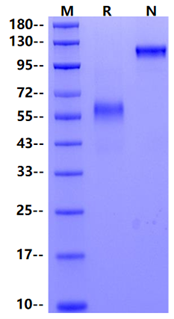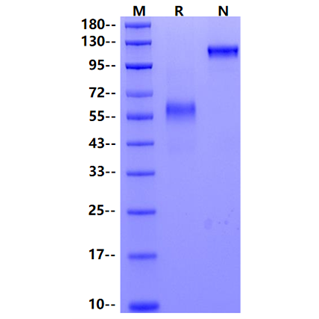1μg (R: reducing conditions, N: non-reducing conditions).
Product Details
Product Details
Product Specification
| Species | Human |
| Antigen | LTBR/TNFRSF3 |
| Synonyms | Lymphotoxin-beta receptor, Tumor necrosis factor C receptor, Tumor necrosis factor receptor 2-related protein |
| Accession | P36941 |
| Amino Acid Sequence | Gln31-Met227, with C-terminal Human IgG Fc QAVPPYASENQTCRDQEKEYYEPQHRICCSRCPPGTYVSAKCSRIRDTVCATCAENSYNEHWNYLTICQLCRPCDPVMGLEEIAPCTSKRKTQCRCQPGMFCAAWALECTHCELLSDCPPGTEAELKDEVGKGNNHCVPCKAGHFQNTSSPSARCQPHTRCENQGLVEAAPGTAQSDTTCKNPLEPLPPEMSGTMLMIEGRMDPKSSDKTHTCPPCPAPELLGGPSVFLFPPKPKDTLMISRTPEVTCVVVDVSHEDPEVKFNWYVDGVEVHNAKTKPREEQYNSTYRVVSVLTVLHQDWLNGKEYKCKVSNKALPAPIEKTISKAKGQPREPQVYTLPPSRDELTKNQVSLTCLVKGFYPSDIAVEWESNGQPENNYKTTPPVLDSDGSFFLYSKLTVDKSRWQQGNVFSCSVMHEALHNHYTQKSLSLSPGK |
| Expression System | HEK293 |
| Molecular Weight | 55-65kDa |
| Purity | >95% by SDS-PAGE |
| Endotoxin | <0.1EU/μg |
| Conjugation | Unconjugated |
| Tag | Human Fc Tag |
| Physical Appearance | Lyophilized Powder |
| Storage Buffer | PBS, pH7.4 |
| Reconstitution | Reconstitute at 0.1-1 mg/ml according to the size in ultrapure water after rapid centrifugation. |
| Stability & Storage | · 12 months from date of receipt, lyophilized powder stored at -20 to -80℃. · 3 months, -20 to -80℃ under sterile conditions after reconstitution. · 1 week, 2 to 8℃ under sterile conditions after reconstitution. · Please avoid repeated freeze-thaw cycles. |
| Reference | 1. Piao W., Xiong Y., Li L., et al. Regulatory T cells condition lymphatic endothelia for enhanced transendothelial migration. Cell Reports. 2020;30(4):1052-1062.e5. |
Background
LTBR is a type 1 single transmembrane protein and member of the tumor necrosis factor receptor (TNFR) family that plays a critical role in the development of secondary lymphoid organs. The human LTBR gene is located on chromosome 12p13, in the same locus as two other members of the TNFR family—TNFR1 and CD27. The human LTBR gene shares 76% homology at the nucleic acid level with its mouse counterpart, located on chromosome 6. LTBR is widely expressed in blood and LECs, intestinal epithelial cells, dendritic cells (DCs), and lymph node (LN) stromal cells. The protein is conspicuously absent in T cells, B cells, and NK cells. LTBR binds strongly to two different natural ligands in homeostatic conditions, LTα1β2 and LIGHT (TNFSF14). LTBR signaling pathway plays an essential role in lymphatic organogenesis, tissue regeneration, organ development, tumorigenesis, and immune response to pathogen infection. Functionally, the absence of LTBR signaling leads to the retention of mature T cells in the thymic medulla.
Picture
Picture
SDS-PAGE



